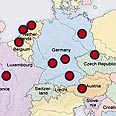
Some some €7 million invested in project
באדיבות יד ושם
Never forget: Shoah archives united
Brussels ceremony inaugurates new project combining Holocaust archives from 13 different countries. 'In order to tell the entire story, all the material must be brought together,' says director of Yad Vashem Archives
The European Holocaust Research Infrastructure (EHRI), which was expected to be inaugurated in Brussels on Tuesday afternoon, has been defined by senior researchers and politicians in Europe and Israel as "the most important project in the study of the Jewish people's Holocaust in the coming years."
The project is aimed at combining all the European archives in Europe with the Yad Vashem Holocaust Museum in Europe under one technological infrastructure. Thirteen countries and 20 research institutes took part in this enterprise over the past four years, at an investment of some €7 million (about $9.5 million).
Anyone who has tried to fine information on a city or Jewish community destroyed during World War II is familiar with this problem. Massive documentation is scattered in many places all over the world. One small typo in a name or the use of one European language instead of another may prevent people from finding what they are looking for or have them drowning in a flood of information, most of which is irrelevant.
This way, very precious information on the lost communities is missed, both personally and in terms of research. Technological developments in the field of information sharing have made it possible to try to bring the pieces together.
The information in question is mainly comprised of collective data about ghettos, cities, and communities, rather than about specific families and names.
A symbolic date was chosen for the inauguration ceremony in Brussels. Exactly 70 years ago, the Warsaw Ghetto was officially "sealed" and the hundreds of thousands of Jews in it were unable to get out.
The Belgian ceremony, sponsored by European Council President Herman Van Rompuy, will be attended by Education Minister Gideon Sa'ar and his Dutch counterpart, the EU commissioner for research, innovation and science, Yad Vashem Chairman Avner Shalev, and Dr. Haim Gertner, director of the Yad Vashem Archives.
Speaking to Ynet from Brussels, Gertner described what he views as "a supreme moral statement on behalf of European countries, which are saying that 'it's important for us to now who our neighbor was and what we have lost.'"
According to Gertner, "This is not a general and vague project about 'the Nazis' victims during the World War,' but rather a specific project about the Jewish people's Holocaust, recognizing its uniqueness."
He illustrated the project's importance through one of many cases – the Theresienstadt Ghetto. Its archive is scattered between Yad Vashem, the Theresienstadt memorial, and the Jewish Museum in Prague. There is also some information in Holland and Hungary.
"In order to tell the entire story, we must bring the material and people responsible for these places together. The new website – just one chain of the entire project – will enable us to make a virtual connection between them and tell their story together."
Guide to be completed in 2014
Gertner added that a complete guide will be available in about four years, allowing any person to look for details in one single place.
"Today in Holland the categorizing is in Dutch, in Yad Vashem it's in Hebrew and English, and in Norway it's in Norwegian. Here were create a dictionary of a common language," he said.
In addition, the project will make it possible to create a virtual – and later physical – connection between people and researchers who can contribute to each others' work."
The project's launching is not being marked in Brussels alone. Kathrin Flor, head of communications at the International Tracing Service in Bad Arolsen, Germany, which documents the fate of the victims of Nazi persecutions, told Ynet this was a historic moment.
"This is undroubtedly the most important project today, because it will not only create a bridge between information that already exists and is scattered in familiar places, but will also provide new information, particularly from less accessible archives in Eastern European countries. We know that there is material there, but we have not had access to it so far."
She gave an example for the current difficulty to find information. "A researcher searches for information on Kristallnacht, and doesn't know whether to look under the date or under the German, English or Hebrew name… and the list goes on. With each option, the researcher may get different answers. At the end of the project being launched today, it will all be combined in one database and the differences will become tiny."
- Follow Ynetnews on Facebook










